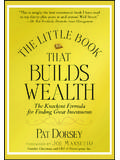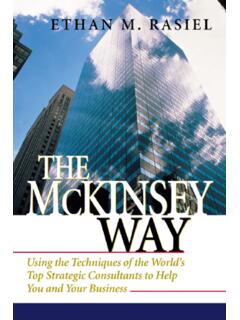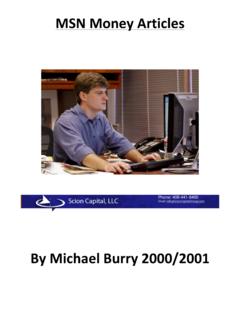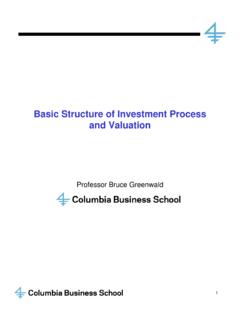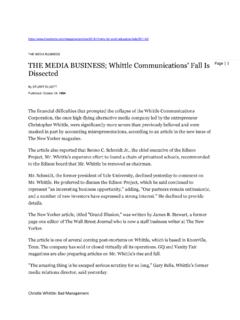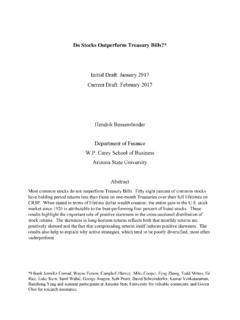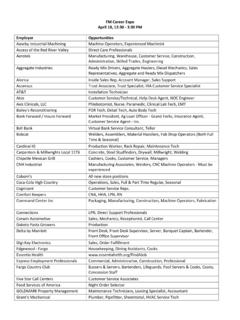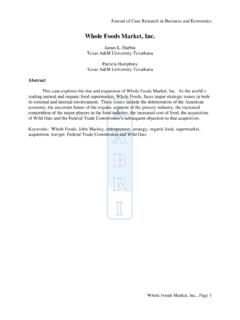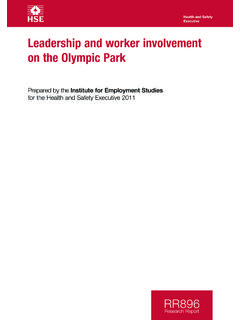Transcription of Table of Contents - csinvesting
1 Table of ContentsLittle Book Big Profits SeriesTitle PageCopyright PageDedicationForewordIntroductionThe Most Important Lesson of AllThe Power of Star TrekSo, Are You Spock or McCoy?X UncheckedChapter One - In the Heat of the MomentThe Perils of ProcrastinationThe Power of Pre-CommitmentChapter Two - Who s Afraid of the Big Bad Market?Brain Drain and PerformanceThe Cure for Temporary ParalysisChapter Three - Always Look on the Bright Side of LifeOptimism and the X-SystemNature versus NurtureBeating Over-OptimismChapter Four - Why Does Anyone Listen to These Guys?Why Does Anyone Listen to Jim Cramer?The Shocking Dangers of Doing What We Are ToldFund Managers: Weathermen or Doctors?Overconfidence May Be Hazardous to Your WealthChapter Five - The Folly of ForecastingSo, Why Do We Keep Forecasting?Why Do We Use Forecasts?
2 There s Got to Be a Better WayChapter Six - Information OverloadIs More Better?When Less Is MoreFrom the Emergency Room to the MarketsChapter Seven - Turn off That Bubblevision!Meet Mr. MarketChapter Eight - See No Evil, Hear No EvilThe Sorry Tale of Sir RogerPrisoners of Our PreconceptionsKill the CompanyChapter Nine - In the Land of the Perma-Bear and the Perma-BullHanging onto Your ViewSunk Costs at the Root of ConservatismChapter Ten - The Siren Song of StoriesStock Market StoriesBeware of Capitalizing HopeFocus on the FactsChapter Eleven - This Time Is DifferentWhy Can t We Time Predictable Surprises?A Beginner s Guide to Spotting BubblesYour Edge Over the Pros!Chapter Twelve - Right for the Wrong Reason, or Wrong for the Right ReasonIt s Not My Fault, It s Just Bad LuckDon t Be a Monday Morning QuarterbackChapter Thirteen - The Perils of ADHD InvestingWhat Can We Learn from Goalkeepers?
3 Poor Performance Increases the Desire to ActInvestors and Action BiasWaiting for the Fat PitchChapter Fourteen - Inside the Mind of a LemmingThe Pain of Going against the CrowdThe Carrot of ConformityThe Dangers of GroupthinkAlone in a Crowd of SheepChapter Fifteen - You Gotta Know When to Fold ThemWe Are Not Alone (or Perhaps Not Even That Evolved!)Myopia and Loss AversionWhy You Can t Bring Yourself to SellThe Endowment EffectChapter Sixteen - Process, Process, ProcessThe Psychology of ProcessProcess AccountabilityConclusionLittle Book Big Profits SeriesIn the Little Book Big Profits series, the brightest icons in the financial world write ontopics that range from tried-and-true investment strategies to tomorrow s new book offers a unique perspective on investing, allowing the reader to pick andchoose from the very best in investment advice in the Little Book Big Profits series include:The Little Book That Beats the Market by Joel Greenblatt The Little Book of Value Investing by Christopher Browne The Little Book of Common Sense Investing by John C.
4 Bogle The Little Book That Makes You Rich by Louis Navellier The Little Book That Builds Wealth by Pat Dorsey The Little Book That Saves Your Assets by David M. Darst The Little Book of Bull Moves in Bear Markets by Peter D. Schiff The Little Book of Main Street Money by Jonathan Clements The Little Book of Safe Money by Jason Zweig The Little Book of Behavioral Investing by James MontierCopyright 2010 by John Wiley & Sons, Ltd. All rights by John Wiley & Sons, Inc., Hoboken, New Jersey. Published simultaneously in part of this publication may be reproduced, stored in a retrieval system, or transmitted in any form or by anymeans, electronic, mechanical, photocopying, recording, scanning, or otherwise, except as permitted underSection 107 or 108 of the 1976 United States Copyright Act, without either the prior written permission of thePublisher, or authorization through payment of the appropriate per-copy fee to the Copyright Clearance Center,Inc.
5 , 222 Rosewood Drive, Danvers, MA 01923, (978) 750-8400, fax (978) 646-8600, or on the web Requests to the Publisher for permission should be addressed to the PermissionsDepartment, John Wiley & Sons, Inc., 111 River Street, Hoboken, NJ 07030, (201) 748-6011, fax (201) 748-6008,or online at of Liability/Disclaimer of Warranty: While the publisher and author have used their best efforts in preparingthis book, they make no representations or warranties with respect to the accuracy or completeness of thecontents of this book and specifically disclaim any implied warranties of merchantability or fitness for aparticular purpose. No warranty may be created or extended by sales representatives or written sales advice and strategies contained herein may not be suitable for your situation. You should consult with aprofessional where appropriate.
6 Neither the publisher nor author shall be liable for any loss of profit or anyother commercial damages, including but not limited to special, incidental, consequential, or other general information on our other products and services or for technical support, please contact ourCustomer Care Department within the United States at (800) 762-2974, outside the United States at (317) 572-3993 or fax (317) also publishes its books in a variety of electronic formats. Some content that appears in print may not beavailable in electronic books. For more information about Wiley products, visit our web site at : 978-0-470-71202-3To CharlotteYour smile lights up my worldForewordHomo MistakusI AM RATHER AN EXPERT ON BAD CHOICES. I have made so many over the years,from unhealthy food choices to postponing exercise (today s bad choice) and yes, evenregrettable investment choices (sigh).
7 And then I have observed so many bad choices on the part of my seven teenagers.(Thankfully, now down to just one, but these days I get to watch my grandkids learn tonavigate the world.) Teenagers have a remarkable ability to make the easy choice todayand postpone the hard and difficult choice until tomorrow. And some of us grow up,having perfected that ability, making even more bad choices as have interviewed hundreds of investors over the years, from small and starting out tohaving-arrived billionaires. I am always amazed by the mistakes they make and theinventive rational they use for having made a nation and a world, we have made numerous bad choices, taken the easy road,and ended up in the worst global economic crisis in 80 years. Now we are faced with aset of difficult choices as we work our way back to a new normal.
8 History is replete withbad choices by both individuals and the past few decades, a new science has emerged that has taken note of the factthat not only are we sometimes irrational, but we are predictably irrational. This newbehavioral science has started looking at how we go about making decisions and isfinding all sorts of interesting, if sometimes distressing, things about the human seems that our emotions and much of our decision-making process is hard wiredinto our brains, developed for survival on the African savannahs some 100,000 yearsago. We adapted to movement, learning to make decisions quickly, because there wasquite a difference, literally life and death, between dodging dangerous lions and chasingsucculent while those survival instincts are quite useful in general, when translated into amodern world, and especially a modern investment world, they make us prone to all sortsof errors.
9 Think of chasing momentum all too often in the hope that it will continue andrunning from falling markets just as they start to turn. What works for survival in theAfrican jungles is not as productive in the jungles of world , we are not just homo mistakus. If we had learned to make nothing but badchoices our species would have been consigned to the dust bin of history a long timeago, making room for some survivors less prone to clearly learned to make good choices as well, and to learn from our mistakes andeven the success and wisdom of others. As I mentioned earlier, I have formallyinterviewed hundreds of millionaires. I am even more fascinated by choices they madethat were the good (and sometimes brilliant!) ones, and the processes they used tomake a human species, there is much to be admired about homo sapiens.
10 We arecapable of great work, soaring ideas, and wonderful compassion, all the results of goodchoices. And behavioral science is helping us to understand how we make as what was once considered the foundations of finance (the efficient markethypothesis, CAPM, and modern portfolio theory) are being questioned and even blamedfor much of the problems in the markets, many of us are looking to the new world ofbehavioral finance for answers to our investment conundrums. By understandingourselves and the way we make decisions, we can often create our own systematicprocess for making the right choices. Whereas we once seemed to be adrift in an oceanof potential choices, with our emotions often dictating the final outcome, with the righttools we can learn to set a confident course to that safe port of problem is that behavioral finance can seem a little daunting, full of studies andinferences, and not tied together very well until now, that is.
